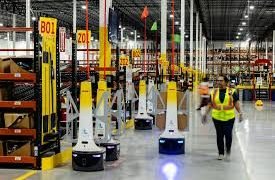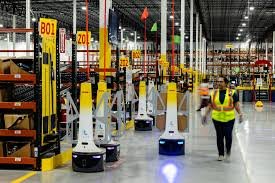Seattle, United States
By Maria Kalamatas | The Logistic News
June 9, 2025 – Section: Tech
Amazon is quietly rewriting the rules of warehouse logistics. In dozens of its U.S. sorting centers, the company has begun deploying a new fleet of mobile robots—machines designed not only to move, but to think.
These new systems, powered by artificial intelligence, are taking on increasingly complex tasks: sorting parcels, navigating warehouse traffic, and even predicting where a backlog might occur before it happens. It’s a vision of logistics where speed is matched by intelligence—and where efficiency isn’t measured in motion alone.
“This isn’t just automation,” said Ravi Chandra, who heads Amazon’s robotics division. “It’s adaptation. These machines learn from the floor, from patterns, from pressure points. That’s where the gains are.”
The robots, which resemble sleek, sensor-packed carts, now operate alongside human teams in more than 50 sites. Unlike earlier models that followed fixed paths, these versions make dynamic decisions in real time. If a route becomes congested, they reroute. If a delay threatens a delivery window, they adjust priorities.
But the story doesn’t stop at hardware. Amazon has also upgraded its logistics brain: a cloud-based AI engine that monitors millions of data points across its network. From temperature-sensitive shipments to last-mile routing, the system helps ensure packages arrive faster and with fewer detours.
“What’s happening here is a blend of precision and prediction,” said Jamie Liu, a logistics innovation consultant. “You’ve got machines doing what they’re good at—and people focusing on what can’t be automated: judgment, quality, and edge cases.”
Inside Amazon, the approach is framed not as a replacement for human labor, but as a reconfiguration. Employees now spend less time walking and lifting, and more time coordinating, solving problems, and overseeing quality control.
Amazon hasn’t announced exact figures, but insiders suggest that robotic handling now covers over 70% of the company’s total parcel volume in major hubs. The goal isn’t just speed, but scalability—making it possible to absorb peak demand without relying on temporary expansion.
With customer expectations higher than ever, the company is betting that intelligence at every step—robotic and human—will keep it ahead of the curve.
✎ Maria Kalamatas
Senior Correspondent – Technology & Innovation
The Logistic News























